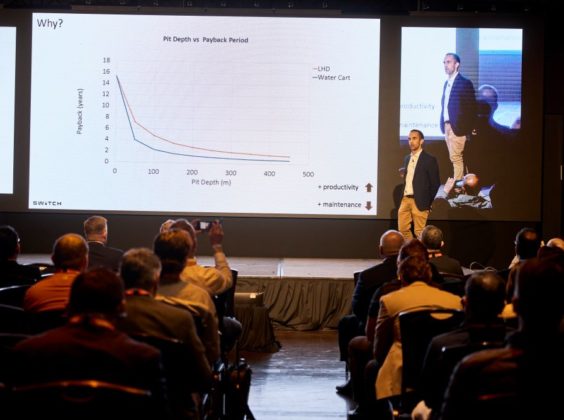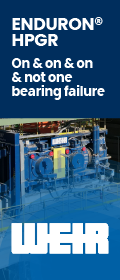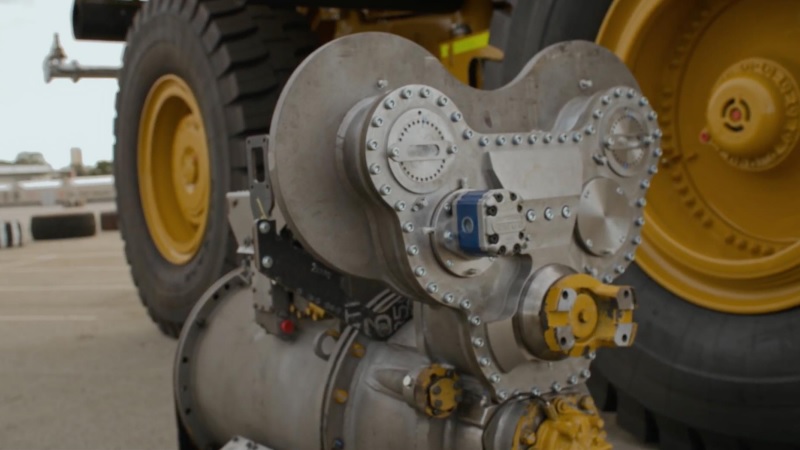Having successfully demonstrated the value of converting a diesel-powered light vehicle to a plug-in hybrid variant, Switch Technologies is about to take another big hybridisation step with the help of lithium mining company, PLS.
The two companies, in collaboration with a Western Australia-based heavy mechanical engineering (HME) rebuilder, aim to convert a 142-t payload diesel-powered Cat 785 Water Cart early next year, demonstrating the capability of the technology to reduce emissions and increase efficiency.
PLS Head of Operations Planning and Performance, Bradley Milne, said that converting the existing fleet could form a critical part of a bridging strategy in the company’s roadmap to eliminate HME diesel fuel usage.
Milne, speaking in a video presented for the first time at The Electric Mine 2025, in Santiago, Chile, said: “We searched very hard for solutions in our class, which is a 150-ton dump truck size, and there isn’t an off-the-shelf product developed that is viable to put into our mine site.”
He said the solution Switch had modelled for the mining company showcased a 17-20% reduction in fuel burn, plus potential increased speed on grade at the Pilgangoora lithium mine site, in Western Australia. “That solution comes out with a financial payback of three years and a reduction in CO2 emissions,” he added.
Mike O’Hanlon (pictured below at The Electric Mine 2025), founder and CTO of Switch, said: “It stacks up commercially when you look at the dollar value impact.” That is even before you factor in the emissions reduction capability.

The conversion process will see Switch and the HME rebuilder take the existing transmission out of the truck – a new Cat 785 Water Cart – remove the transfer case off the front of this transmission, bolt in a modified transmission with a brand new transfer case and put that “assembly” back in the truck. That transfer case includes an extended set of gears that allow Switch to hang two 540 kW motors off it.
“The interfaces between the truck and the transmission are unchanged,” O’Hanlon said, later clarifying that Caterpillar would unlikely uphold the transmission warranty on the truck after such a retrofit.
He added: “There is a very sensible rationale for putting so much power into the truck…you need a lot of power to capture a lot of braking energy…The system can capture 86% of that braking effort.”
Between the tyres on one side of the vehicle is a 113-kWh battery pack powered by XNO® battery chemistry.
This battery pack is provided by niobium battery anode materials provider Echion Technologies, with Benjamin Ting, CCO of Echion, telling The Electric Mine 2025 delegates: “This is the best battery suited to a hybrid haul truck application.”
Jan Haak, Managing Director and Chief Revenue Officer of Switch Technologies, fleshed out this statement by explaining that the niobium-based battery chemistry of XNO offered a 40% reduction in volume and a 30% reduction in “mass” relative to the best available LTO option.
“It is heavy hybrid applications that XNO is really suited to,” he added.
The truck in question is expected to only require small “opportunity charging” windows depending on the haul cycle, with O’Hanlon telling IM previously that the truck was designed to be “purely regenerative”.
Switch plans to, once again, utilise the Australian Automation and Robotics Precinct (AARP) just outside of Perth, to test out the truck ahead of the converted 785 going to Pilgangoora. The AARP also acted as a testbed for the Toyota Land Cruiser 79 Series vehicle that has been modified into a plug-in hybrid configuration with a 24-kWh battery.
The truck will then progress to PLS’ Pilgangoora site in the Pilbara for a trial period. O’Hanlon was confident that, if the trial was successful, there would be an opportunity to install follow-on retrofits at mine sites, which could be completed in a matter of weeks.
“We expect the Switch strategy to iterate and change over time as we learn from the PLS (Pilgangoora) trial,” Haak said, adding that driving lower cost of operations and reducing carbon emissions would continue to be mainstay aims.
With commercial deployments of the retrofit truck solution expected from April 2026, Haak and O’Hanlon are already seeing growth opportunities beyond the 785 size class.
Haak said: “The transfer case of the 785 is identical to the 789, so there is an obvious opportunity there. We also have customers asking about 793s and other OEMs in contact too.”











